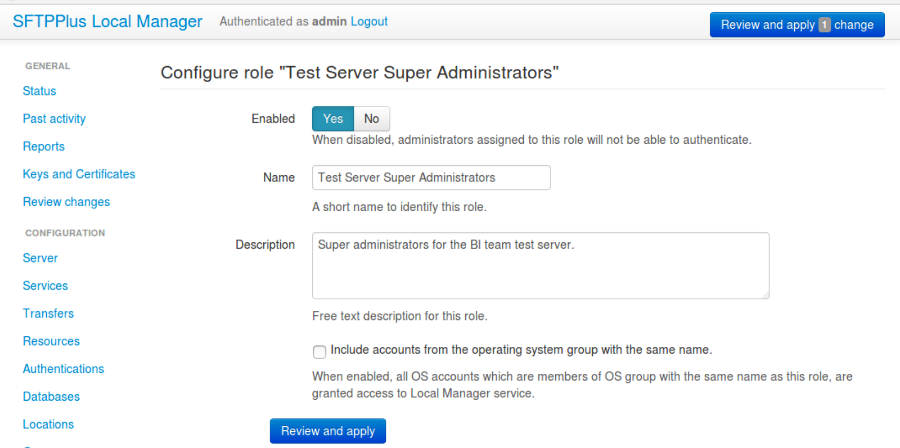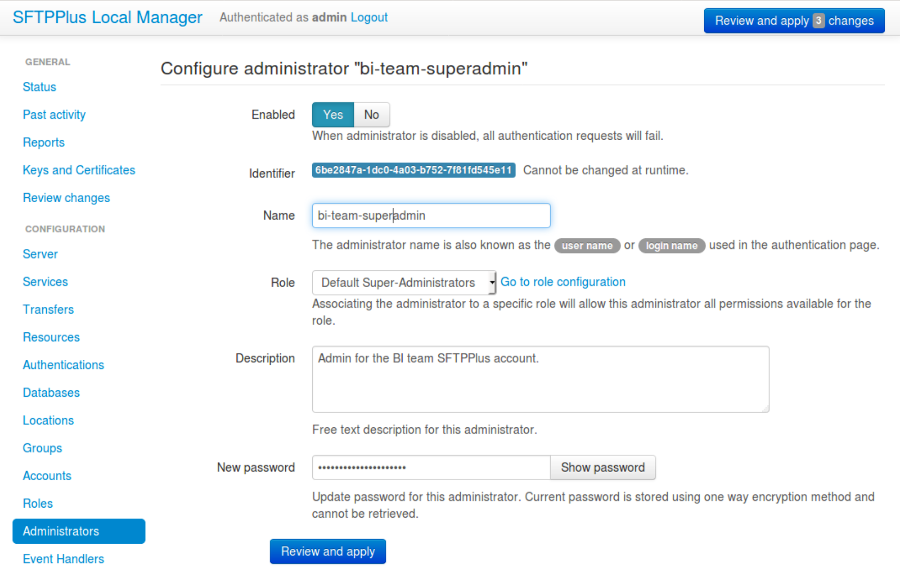Documentation
4.10. Administrators¶
Administrators are dedicated to accessing the Local Manager administration service. They cannot be used for file transfer operations.
In order to simplify configuration management for a large number of administrators, the administrators are associated to a role.
This allows, for example, to easily disable access for all administrators associated to a particular role by simply disabling the role instead of having to disable every administrator.
4.10.1. Roles¶
The roles represent a collection of permissions for Local Manager administrators that can be individually turned on and off.
An administrator can have one or more roles.
An administrator must have at least one role. The first associated role is considered the primary one.
Roles can also be associated to operating system groups. In this way, you can allow access for administrators defined in operating system groups, e.g. using a Domain Controller or other centralized identity management systems, just like you would for an application-level administrator.
A role can be shared between operating system groups and application-level administrators.
Note
The name role is used to avoid confusion with groups of regular
accounts.
4.10.2. Adding a new role via Local Manager¶
Roles can be added or changed via Local Manager below.

4.10.3. Adding a new role via text configuration¶
Adding a new role is done by creating a new section inside the configuration
file.
The name of the section should be prefixed with roles/ and followed by the
role's UUID.
The role's UUID can be any unique string used to identify the role. Once defined, the UUID should not be changed.
For more information, please see the dedicated UUID documentation.
For example, to add a new role named SuperAdmins:
[roles/a904e3a6-a59b-4bbf-8abd-edcae4d3774f]
name = SuperAdmins
enabled = Yes
description = Administrators having unrestricted access to Local Manager.
4.10.4. Adding a new administrator via Local Manager¶
Administrators can be added or changed via Local Manager below.

4.10.5. Adding a new administrator via text configuration¶
Adding a new administrator is done by creating a new section inside the
configuration file.
The name of the section should be prefixed with administrators/ and
followed by the administrator's UUID.
The administrator's UUID can be any unique string used to identify the administrator. Once defined, the UUID should not be changed.
For more information, please see the dedicated UUID documentation.
An administrator can be an application-level account defined for accessing the Local Manager or a local operating system account belonging to an operating system group associated to a role.
For example, to add a new administrator named sa-admin:
[administrators/804aab78-70c0-4e1d-8480-4979e169a0a2]
name = sa-admin
enabled = Yes
description = Administrator account for our super admin.
password = $5$rounds=1000$utwEAUxeFBXSF0Uf$klQTAMRygQfijPXMYZCddVug
role = 404aab78-70c0-4e1d-8480-4979e169a0a4
Note
The server does not support authentication of operating system administrators that are used for multiple roles. In this case, the result is undefined.
Note
Administrator names and passwords longer than 150 characters are not allowed by SFTPPlus. Generating passwords longer than 128 characters is not possible either. These restrictions prevent denial of service attacks.
4.10.6. Configuration options for roles¶
The following configuration options are available for roles:
4.10.6.1. enabled¶
- Default value
Yes
- Optional
Yes
- From version
2.1.0
- Values
Yes
No
- Description
This option specifies whether or not this role is disabled.
When a role is disabled, authentication is denied to all administrators associated with the disabled role.
4.10.6.2. name¶
- Default value
''
- Optional
No
- From version
2.1.0
- Values
Any text.
Name of an existing group defined in the operating system.
- Description
Human-readable short string used to identify this role.
4.10.6.3. description¶
- Default value
''
- Optional
Yes
- From version
2.1.0
- Values
Any character string.
- Description
Human-readable text that describes the purpose of this role.
4.10.6.4. source_ip_filter¶
- Default value
Empty
- Optional
Yes
- From version
4.14.0
- Values
IPv4 address
IPv6 address
Classless Inter-Domain Routing subnet notation.
Comma-separated list of IPv4, IPv6 addresses, or CIDR values.
Empty
- Description
This option defines the source IP addresses (v4 or v6) from which administrators in this role are allowed to authenticate.
Leave empty to allow any IP address.
4.10.6.5. permissions¶
- Default value
*, all
- Optional
Yes
- From version
4.15.0
- Values
Multiple lines of comma-separated definitions of permissions
target-rule, comma, separated, actions
- Description
This defines the permissions available to administrators associated to this role.
When this option is empty, the role has full access.
The option is defined as a list of one or more definitions of permissions, with one definition per line.
A definition of permissions is a comma-separated list of values. The first value is an expression defining the targeted elements of the permissions. The remaining values are the actions allowed to be performed on the targeted elements.
The following element target classes are available:
configuration - includes all the configuration elements
sync_pull - allows reading full configuration by a secondary instance for synchronization.
The following actions are available:
all - allow any action
read - allow reading the current configuration value or the state of a component
update - allow modifying / updating the value of a configuration or the state (start/stop) of a component
create - allow creating new configuration values
delete - allow removing existing configuration values
deny - this is a special value designed for complex scenarios and which will deny any action and stop processing any other rules. Most of the time you will not need to use it as the deny action is applied by default for any target.
If no actions are defined for a definition, the all action is used by default.
Once a target reaches the deny action the operation is denied and no further rules are checked. It takes precedence over any other configured action.
When the all action is configured together with other actions like create or update, they are ignored and only the all action is used.
To allow an action, it must be matched with an explicit permission rule.
The order of the rules doesn't matter, unless your configuration contains a rule using the deny action.
The rules are checked from top to bottom. If an action is not explicitly allowed by permissions rule, the process continues to check following defined permissions rules.
For example, to create a role in which administrators are allowed to read/view the full configuration, modify the existing groups, and create and delete accounts, you can use the following configuration:
[roles/70c0-4e1d-8480] name = users-admin permissions = configuration, read configuration/identity/accounts, create, delete, update configuration/identity/groups, create, update
More information and examples are available on the Administrators authorization page.
4.10.7. Options for administrators¶
The following configuration options are available for administrators.
4.10.7.1. enabled¶
- Default value
Yes
- Optional
Yes
- From version
2.1.0
- Values
Yes
No
- Description
This option specifies whether or not to enable access for this administrator.
4.10.7.2. name¶
- Default value
''
- Optional
No
- From version
2.1.0
- Values
Any alphanumeric string including space, _ or -.
- Description
Human-readable short string used to identify this administrator.
It also represents the
loginorusernamevalue for this administrator.
4.10.7.3. description¶
- Default value
''
- Optional
Yes
- From version
2.1.0
- Values
Any character string.
- Description
Human-readable text that identifies the person or entity to use this administrator account and/or describes the account's purpose.
Example:
[administrators/92ad5b32-d8d7-4ed8-94e1-dbb9f01383f4] description = Administrator from the SA team. Contact: someone@email.tld name = sa-operator
4.10.7.4. password¶
- Default value
Empty
- Optional
Yes
- From version
2.1.0
- Values
Password encrypted using a one-way cryptographic hash function.
Empty.
- Description
This option specifies the password used for validating the credentials for this administrator.
It is stored encrypted using the cryptographic hash function SHA-256.
To get the hashed password please check how to generate encrypted passwords using admin-commands.
When the password left empty, the administrator will not be able to authenticate, even if the enabled option is set to yes.
4.10.7.5. source_ip_filter¶
- Default value
inherit
- Optional
Yes
- From version
4.14.0
- Values
IPv4 address
IPv6 address
Classless Inter-Domain Routing subnet notation.
Comma-separated list of IPv4, IPv6 addresses, or CIDR values.
Empty
inherit
- Description
This option defines the source IP addresses (v4 or v6) from which administrators are allowed to authenticate.
Leave it empty to allow any IP address.
Set it to inherit to use the value from the role.
4.10.7.6. multi_factor_authentication¶
- Default value
Empty
- Optional
Yes
- From version
4.0.0
- Values
OTP Authentication URL
Empty.
- Description
This option specifies the One-Time Password shared secret associated with this administrator, stored as an otpauth:// URL, as defined by the Google Authenticator
More information on 2-step authentication is available in the cryptography guide page.
4.10.7.7. roles¶
- Default value
DEFAULT-ROLE
- Optional
No
- From version
4.16.0
- Values
UUID of a role.
Comma-separated UUID of roles
- Description
This option defines the roles associated with this administrator.
It can be configured with one or multiple role UUIDs.
The first UUID is the primary role of this administrator.
Updating this configuration doesn't impact the sessions of already authenticated administrators, which continue to use the old configuration value. The new value is only used for new authentications.